General/Doctor
James Harold "Jimmy" Doolittle, USAF (December
14, 1896 – September 27, 1993) was an American aviation
pioneer. Doolittle served as an officer in the United
States Army Air Forces during the Second World War. He
earned the Medal of Honor for his valor and leadership
as commander of the Doolittle Raid while a lieutenant
colonel.
Early
life and education
Doolittle
was born in Alameda, California, and spent his youth in
Nome, Alaska, where he earned a reputation as a boxer.
His parents were Frank Henry Doolittle and Rosa (Rose)
Cerenah Shephard. By 1910, Jimmy Doolittle was attending
school in Los Angeles. When his school attended the 1910
Los Angeles International Air Meet at Dominguez Field
Doolittle saw his first airplane. He attended Los Angeles
City College after graduating from Manual Arts High School
in Los Angeles, and later won admission to the University
of California, Berkeley where he studied in The School
of Mines. He was a member of Theta Kappa Nu fraternity.
Doolittle took a leave of absence in October 1917 to enlist
in the Signal Corps Reserve as a flying cadet; he ground
trained at the School of Military Aeronautics (an army
school) on the campus of the University of California,
and flight-trained at Rockwell Field, California. Doolittle
received his Reserve Military Aviator rating and was commissioned
a first lieutenant in the Signal Officers Reserve Corps
on March 11, 1918.
Military
career
During
World War I, Doolittle stayed in the United States as
a flight instructor and performed his war service at Camp
John Dick Aviation Concentration Center ("Camp Dick"),
Texas; Wright Field, Ohio; Gerstner Field, Louisiana;
Rockwell Field, California; Kelly Field, Texas and Eagle
Pass, Texas.
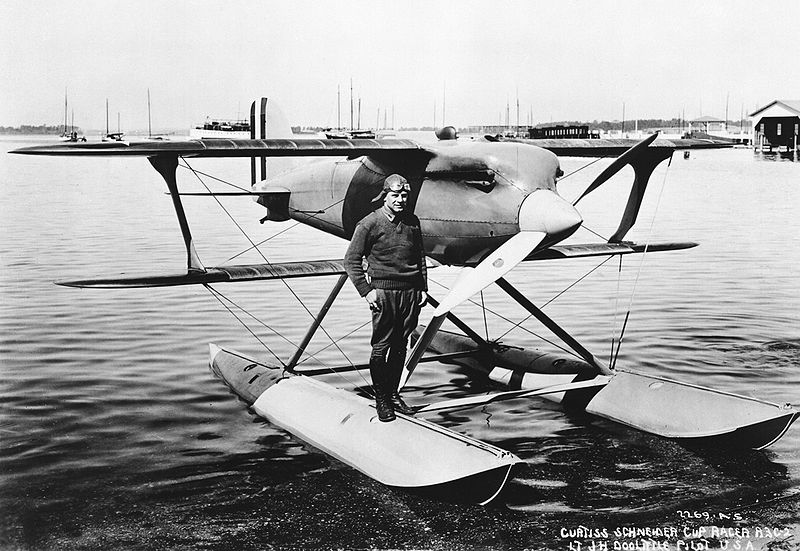
Doolittle on his Curtiss R3C-2 Racer, the plane in which
he won the 1925 Schneider Trophy Race
Doolittle's
service at Rockwell Field consisted of duty as a flight
leader and gunnery instructor. At Kelly Field, he served
with the 104th Aero Squadron and with the 90th Aero Squadron
of the 1st Surveillance Group. His detachment of the 90th
Aero Squadron was based at Eagle Pass, patrolling the
Mexican border. Recommended by three officers for retention
in the Air Service during demobilization at the end of
the war, Doolittle qualified by examination and received
a Regular Army commission as a 1st Lieutenant, Air Service,
on July 1, 1920.
On
May 10, 1921, he was engineering officer and pilot for
an expedition recovering a plane that had force-landed
in a Mexican canyon on February 10 during a transcontinental
flight attempt by Lieut. Alexander Pearson. Doolittle
reached the plane on May 3 and found it serviceable, then
returned May 8 with a replacement motor and four mechanics.
The oil pressure of the new motor was inadequate and Doolittle
requested two pressure gauges, using carrier pigeons to
communicate. The additional parts were dropped by air
and installed, and Doolittle flew the plane to Del Rio,
Texas himself, taking off from a 400-yard airstrip hacked
out of the canyon floor.
Subsequently,
he attended the Air Service Mechanical School at Kelly
Field and the Aeronautical Engineering Course at McCook
Field, Ohio. Having at last returned to complete his college
degree, he earned the Bachelor of Arts from the University
of California, Berkeley in 1922, and joined the Lambda
Chi Alpha Fraternity.
Doolittle
was one of the most famous pilots during the inter-war
period. In September 1922, he made the first of many pioneering
flights, flying a de Havilland DH-4 – which was equipped
with early navigational instruments – in the first
cross-country flight, from Pablo Beach (renamed Jacksonville
Beach), Florida, to Rockwell Field, San Diego, California,
in 21 hours and 19 minutes, making only one refueling
stop at Kelly Field. The U.S. Army awarded him the Distinguished
Flying Cross.
Within
days after the transcontinental flight, he was at the
Air Service Engineering School (a precursor to the Air
Force Institute of Technology) at McCook Field, Dayton,
Ohio. For Doolittle, the school assignment had special
significance: "In the early '20s, there was not complete
support between the flyers and the engineers. The pilots
thought the engineers were a group of people who zipped
slide rules back and forth, came out with erroneous results
and bad aircraft; and the engineers thought the pilots
were crazy – otherwise they wouldn't be pilots. So
some of us who had had previous engineering training were
sent to the engineering school at old McCook Field. ...
After a year's training there in practical aeronautical
engineering, some of us were sent on to MIT where we took
advanced degrees in aeronautical engineering. I believe
that the purpose was served, that there was thereafter
a better understanding between pilots and engineers."
In
July 1923, after serving as a test pilot and aeronautical
engineer at McCook Field, Doolittle entered the Massachusetts
Institute of Technology. In March 1924, he conducted aircraft
acceleration tests at McCook Field, which became the basis
of his master's thesis and led to his second Distinguished
Flying Cross. He received his S.M. in Aeronautics from
MIT in June 1924. Because the Army had given him two years
to get his degree and he had done it in just one, he immediately
started working on his Sc.D. in Aeronautics, which he
received in June 1925. He said that he considered his
master's work more significant than his doctorate.
Following
graduation, Doolittle attended special training in high-speed
seaplanes at Naval Air Station Anacostia in Washington,
D.C.. He also served with the Naval Test Board at Mitchel
Field, Long Island, New York, and was a familiar figure
in air speed record attempts in the New York area. He
won the Schneider Cup race in a Curtiss R3C in 1925 with
an average speed of 232 MPH. For that feat, Doolittle
was awarded the Mackay Trophy in 1926.
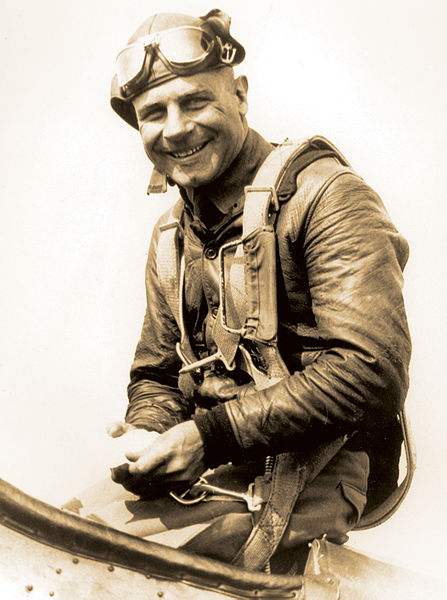
Doolittle
in a pre-World War II photo
In
April 1926, Doolittle was given a leave of absence to
go to South America to perform demonstration flights.
In Chile, he broke both ankles, but put his P-1 Hawk through
aerial maneuvers with his ankles in casts. He returned
to the United States, and was confined to Walter Reed
Army Hospital for his injuries until April 1927. Doolittle
was then assigned to McCook Field for experimental work,
with additional duty as an instructor pilot to the 385th
Bomb Squadron of the Air Corps Reserve. During this time,
in 1927 he was the first to perform an outside loop previously
thought to be a fatal maneuver. Carried out in a Curtiss
fighter at Wright Field in Ohio, Doolittle executed the
dive from 10,000 feet, reached 280 miles per hour, bottomed
out upside down, then climbed and completed the loop.
Instrument
flight
Doolittle's
most important contribution to aeronautical technology
was the development of instrument flying. He was the first
to recognize that true operational freedom in the air
could not be achieved unless pilots developed the ability
to control and navigate aircraft in flight, from takeoff
run to landing rollout, regardless of the range of vision
from the cockpit. Doolittle was the first to envision
that a pilot could be trained to use instruments to fly
through fog, clouds, precipitation of all forms, darkness,
or any other impediment to visibility; and in spite of
the pilot's own possibly confused motion sense inputs.
Even at this early stage, the ability to control aircraft
was getting beyond the motion sense capability of the
pilot. That is, as aircraft became faster and more maneuverable,
pilots could become seriously disoriented without visual
cues from outside the cockpit, because aircraft could
move in ways that pilots' senses could not accurately
decipher.
Doolittle
was also the first to recognize these psycho-physiological
limitations of the human senses (particularly the motion
sense inputs, i.e., up, down, left, right). He initiated
the study of the subtle interrelationships between the
psychological effects of visual cues and motion senses.
His research resulted in programs that trained pilots
to read and understand navigational instruments. A pilot
learned to "trust his instruments," not his
senses, as visual cues and his motion sense inputs (what
he sensed and "felt") could be incorrect or
unreliable.
In
1929, he became the first pilot to take off, fly and land
an airplane using instruments alone, without a view outside
the cockpit. Having returned to Mitchel Field that September,
he assisted in the development of fog flying equipment.
He helped develop, and was then the first to test, the
now universally used artificial horizon and directional
gyroscope. He attracted wide newspaper attention with
this feat of "blind" flying and later received
the Harmon Trophy for conducting the experiments. These
accomplishments made all-weather airline operations practical.
In
January 1930, he advised the Army on the building of Floyd
Bennett Field in New York City. Doolittle resigned his
regular commission on February 15, 1930, and was commissioned
a major in the Air Reserve Corps a month later, being
named manager of the Aviation Department of Shell Oil
Company, in which capacity he conducted numerous aviation
tests. While in the Reserve, he also returned to temporary
active duty with the Army frequently to conduct tests.
Doolittle
helped influence Shell Oil Company to produce the first
quantities of 100 octane aviation gasoline. High octane
fuel was crucial to the high-performance planes that were
developed in the late 1930s.
In
1931, Doolittle won the Bendix Trophy Race from Burbank,
California, to Cleveland, Ohio, in a Laird Super Solution
biplane.
In
1932, Doolittle set the world's high speed record for
land planes at 296 miles per hour in the Shell Speed Dash.
Later, he took the Thompson Trophy Race at Cleveland in
the notorious Gee Bee R-1 racer with a speed averaging
252 miles per hour. After having won the three big air
racing trophies of the time, the Schneider, Bendix, and
Thompson, he officially retired from air racing stating,
"I have yet to hear anyone engaged in this work dying
of old age."
In
April 1934, Doolittle became a member of the Baker Board.
Chaired by former Secretary of War Newton D. Baker, the
board was convened during the Air Mail scandal to study
Air Corps organization. A year later, Doolittle transferred
to the Air Corps Reserve. In 1940, he became president
of the Institute of Aeronautical Science.
Doolittle
returned to active duty on July 1, 1940 with rank of Major.
He was assigned as the assistant district supervisor of
the Central Air Corps Procurement District at Indianapolis,
Indiana, and Detroit, Michigan, where he worked with large
auto manufacturers on the conversion of their plants for
production of planes. The following August, he went to
England as a member of a special mission and brought back
information about other countries' air forces and military
build-ups.
The
Doolittle Raid
Doolittle
was promoted to Lieutenant Colonel on January 2, 1942,
and assigned to Army Air Forces Headquarters to plan the
first retaliatory air raid on the Japanese homeland. He
volunteered for and received General H.H. Arnold's approval
to lead the top-secret attack of 16 B-25 medium bombers
from the aircraft carrier USS Hornet, with targets in
Tokyo, Kobe, Yokohama, Osaka, and Nagoya. After training
at Eglin Field and Wagner Field in northwest Florida,
Doolittle, his aircraft and flight crews proceeded to
the McClellan Field, California for aircraft modifications
at the Sacramento Air Depot, followed by a short final
flight to Naval Air Station Alameda, California for embarkation
aboard USS Hornet. On April 18, all the bombers successfully
took off from the Hornet, reached Japan, and bombed their
targets. Fifteen of the planes then headed for their recovery
airfield in China, while one crew chose to land in Russia
due to their bomber's unusually high fuel consumption.
As did most of the other crewmen who participated in the
mission, Doolittle's crew bailed out safely over China
when their bomber ran out of fuel. By then they had been
flying for about 12 hours, it was nighttime, the weather
was stormy, and Doolittle was unable to locate their landing
field. Doolittle came down in a rice paddy (saving a previously
injured ankle from breaking) near Chuchow (Quzhou). He
and his crew linked up after the bailout and were helped
through Japanese lines by Chinese guerrillas and American
missionary John Birch. Other aircrews were not so fortunate.
Although most eventually reached safety with the help
of friendly Chinese, four crewmembers lost their lives
as a result of being captured by the Japanese and three
due to aircraft crash and/or while parachuting. Doolittle
went on to fly more combat missions as commander of the
12th Air Force in North Africa, for which he was awarded
four Air Medals. The other surviving members of the raid
also went on to new assignments.
Doolittle
received the Medal of Honor from President Franklin D.
Roosevelt at the White House for planning and leading
his raid on Japan. His citation reads: "For conspicuous
leadership above and beyond the call of duty, involving
personal valor and intrepidity at an extreme hazard to
life. With the apparent certainty of being forced to land
in enemy territory or to perish at sea, Lt. Col. Doolittle
personally led a squadron of Army bombers, manned by volunteer
crews, in a highly destructive raid on the Japanese mainland."
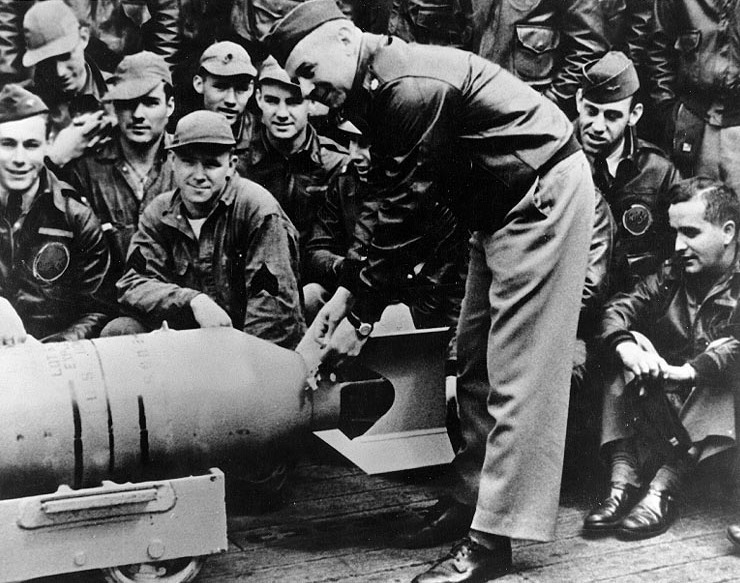
Lt Col James H. Doolittle, USAAF (front), leader of the
raiding force,
wires a Japanese medal to a 500-pound bomb, during ceremonies
on the
flight deck of USS Hornet (CV-8), shortly before his force
of sixteen B-25B
bombers took off for Japan. The planes were launched on
April 18, 1942.
The
Doolittle Raid is viewed by historians as a major morale-building
victory for the United States. Although the damage done
to Japanese war industry was minor, the raid showed the
Japanese that their homeland was vulnerable to air attack,
and forced them to withdraw several front-line fighter
units from Pacific war zones for homeland defense. More
significantly, Japanese commanders considered the raid
deeply embarrassing, and their attempt to close the perceived
gap in their Pacific defense perimeter led directly to
the decisive American victory during the Battle of Midway
in June 1942.
When
asked from where the Tokyo raid was launched, President
Roosevelt coyly said its base was Shangri-La, a fictional
paradise from the popular novel Lost Horizon. In the same
vein, the US Navy named one of its carriers the USS Shangri-La.
World
War II, post-raid
In
July 1942, as a Brigadier General – he had been promoted
by two grades on the day after the Tokyo attack, by-passing
the rank of full colonel – Doolittle was assigned
to the nascent Eighth Air Force and in September became
commanding general of the Twelfth Air Force in North Africa.
He was promoted to Major General in November 1942, and
in March 1943 became commanding general of the Northwest
African Strategic Air Forces, a unified command of U.S.
Army Air Force and Royal Air Force units.
Maj.
Gen. Doolittle took command of the Fifteenth Air Force
in the Mediterranean Theater of Operations in November
1943. On June 10, he flew as co-pilot with Jack Sims,
fellow Tokyo Raider, in a B-26 Marauder of the 320th Bombardment
Group, 442nd Bombardment Squadron on a mission to attack
gun emplacements at Pantelleria. Doolittle continued to
fly, despite the risk of capture, while being privy to
the Ultra secret, which was that the German encryption
systems had been broken by the British. From January 1944
to September 1945, he held his largest command, the Eighth
Air Force (8 AF) in England as a Lieutenant General, his
promotion date being March 13, 1944 and the highest rank
ever held by a reserve officer in modern times. Doolittle's
major influence on the European air war occurred early
in the year when he changed the policy requiring escorting
fighters to remain with the bombers at all times. With
his permission, P-38s, P-47s, and P-51s on escort missions
strafed German airfields and transport while returning
to base, contributing significantly to the achievement
of air supremacy by Allied Air Forces over Europe.
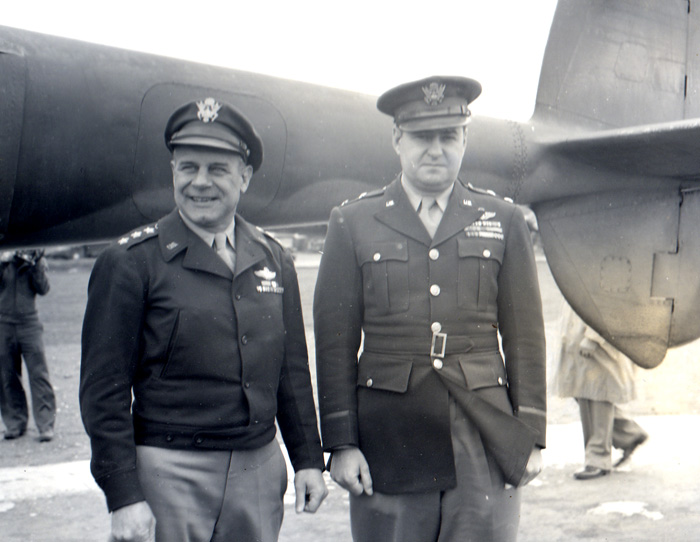
Lt Gen Jimmy Doolittle with Maj Gen Curtis LeMay standing
in front of a Lockheed P-38 Lightning in Britain, 1944.
After
the end of the European war, the Eighth Air Force was
re-equipped with B-29 Superfortress bombers and started
to relocate to Okinawa in the Pacific. Two bomb groups
had begun to arrive on August 7. However, the 8th was
not scheduled to be at full strength until February 1946
and Doolittle declined to rush 8th Air Force units into
combat saying that "If the war is over, I will not
risk one airplane nor a single bomber crew member just
to be able to say the 8th Air Force had operated against
the Japanese in the Pacific".
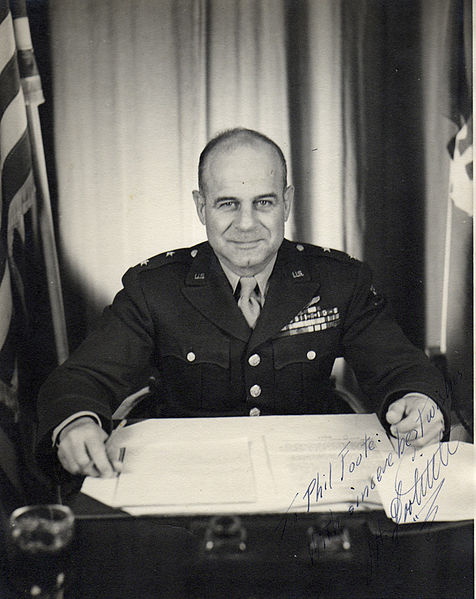
Personalized
photo of General Jimmy Doolittle.
Postwar
On
May 10, 1946, Doolittle reverted to inactive reserve status
at the grade of lieutenant general, a rarity in those
days when nearly all other reserve officers were limited
to the rank of major general or rear admiral, a restriction
that would not end in the US armed forces until the 21st
century. Doolittle returned to Shell Oil as a vice president,
and later as a director.
In
the summer of 1946 Doolittle went to Stockholm where he
was consulted about the "ghost rockets" than
had been observed over Scandinavia.
In
1947, Doolittle also became the first president of the
Air Force Association, an organization which he helped
create.
In
March 1951, Doolittle was appointed a special assistant
to the Chief of Staff of the Air Force, serving as a civilian
in scientific matters which led to Air Force ballistic
missile and space programs. In 1952, following a string
of three air crashes in two months at Elizabeth, New Jersey,
the President of the United States, Harry S. Truman, appointed
him to lead a presidential commission examining the safety
of urban airports. The report "Airports And Their
Neighbours" led to zoning requirements for buildings
near approaches, early noise control requirements, and
initial work on "super airports" with 10,000
ft runways, suited to 150 ton aircraft.
In
1954, President Dwight D. Eisenhower asked Doolittle to
perform a study of the Central Intelligence Agency; The
resulting work was known as the Doolittle Report, 1954,
and was classified for a number of years.
Doolittle
retired from Air Force duty on February 28, 1959. He remained
active in other capacities, including chairman of the
board of TRW Space Technology Laboratories.
In
the mid-1960s, Doolittle visited South Africa and praised
the system of apartheid.
In
1972, Doolittle received the Tony Jannus Award for his
distinguished contributions to commercial aviation, in
recognition of the development of instrument flight.
On
April 4, 1985, the U.S. Congress promoted Doolittle to
the rank of full General on the Air Force retired list.
In a later ceremony, President Ronald Reagan and U.S.
Senator and retired Air Force Reserve Major General Barry
Goldwater pinned on Doolittle's four-star insignia.

Doolittle
is awarded a fourth star, pinned on by President Ronald
Reagan (left)
and Senator Barry Goldwater (right), April 10, 1985.
In
addition to his Medal of Honor for the Tokyo raid, Doolittle
also received the Presidential Medal of Freedom, two Distinguished
Service Medals, the Silver Star, three Distinguished Flying
Crosses, the Bronze Star, four Air Medals, and decorations
from Great Britain, France, Belgium, Poland, China, and
Ecuador. He is the only person to be awarded both the
Medal of Honor and the Medal of Freedom, the nation's
two highest honors. Doolittle was awarded the Public Welfare
Medal from the National Academy of Sciences in 1959. In
1983, he was awarded the United States Military Academy's
Sylvanus Thayer Award. He was inducted in the Motorsports
Hall of Fame of America as the only member of the air
racing category in the inaugural class of 1989, and into
the Aerospace Walk of Honor in the inaugural class of
1990. The headquarters of the United States Air Force
Academy Association of Graduates (AOG) on the grounds
of the United States Air Force Academy, Doolittle Hall,
is named in his honor.
On
May 9, 2007, the new 12th Air Force Combined Air Operations
Center (CAOC), Building 74, at Davis-Monthan Air Force
Base in Tucson, Arizona, was named in his honor as the
"General James H. Doolittle Center." Several
surviving members of the Doolittle Raid were in attendance
during the ribbon cutting ceremony.
Personal
life
Doolittle
married Josephine "Joe" E. Daniels on December
24, 1917. At a dinner celebration after Jimmy Doolittle's
first all-instrument flight in 1929, Josephine Doolittle
asked her guests to sign her white damask tablecloth.
Later, she embroidered the names in black. She continued
this tradition, collecting hundreds of signatures from
the aviation world. The tablecloth was donated to the
Smithsonian Institution. Married for over 70 years, Josephine
Doolittle died in 1988, five years before her husband.
The
Doolittles had two sons, James Jr., and John. Both became
military aviators. James Jr. was an A-26 Invader pilot
during World War II and committed suicide at the age of
thirty-eight in 1958. At the time of his death, James
Jr. was a Major and commander of the 524th Fighter-Bomber
Squadron, piloting the F-101 Voodoo.
His
other son, John P. Doolittle, retired from the Air Force
as a Colonel, and his grandson, Colonel James H. Doolittle,
III, was the vice commander of the Air Force Flight Test
Center at Edwards Air Force Base, California.
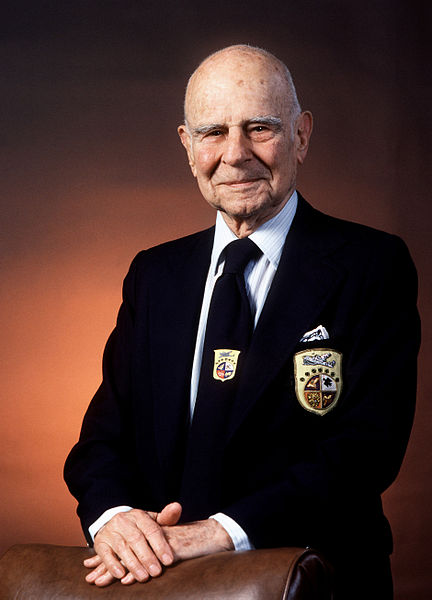
Doolittle
photographed in 1986.
James
H. "Jimmy" Doolittle died at the age of 96 in
Pebble Beach, California on September 27, 1993, and is
buried at Arlington National Cemetery in Virginia, near
Washington, D.C., next to his wife. In his honor at the
funeral, there was also a flyover of Miss Mitchell, a
lone B-25 Mitchell, and USAF Eighth Air Force bombers
from Barksdale Air Force Base, Louisiana. After a brief
graveside service, Doolittle's great-grandson played Taps
flawlessly.
Source:
http://en.wikipedia.org/wiki/Jimmy_Doolittle
